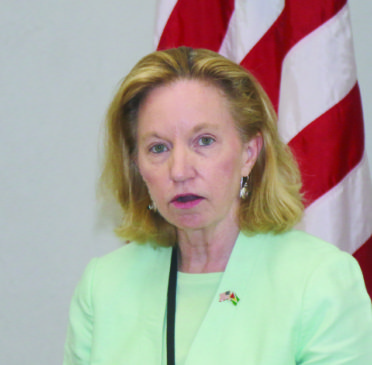
…after ranking number 1 for South America in 2017
The Zika virus has seen a steep decline in Guyana due to a number of partnerships which worked to reduce the number of infected persons, especially pregnant mothers and children.
This is according to the United States Ambassador to Guyana, Sarah Ann Lynch, during the conclusion of the Maternal and Child Survival Programme (MCSP), which initiated in March 2018 to combat the Zika epidemic in this part of the world.
Addressing a gathering of health workers, the Ambassador relayed, “This important health partnership between out governments supported clinical and non-clinical Zika services benefitting infants, children and families across Guyana…Thanks to the continuous and dedicated work to curb the spread of mosquito-borne illnesses, reported Zika cases have decreased”.
The virus spreads from mosquitoes of the Aedes genus, primarily the Aedes Aegypti species. While there are usual symptoms in infected persons, pregnant women are at risk since a serious birth defect called microcephaly and brain defects are noted.
As such, the US diplomat warned that while the statistics are presently low, there will be other outbreaks in the future. This requires preparation and attentive medical practitioners.
“The significant decrease in cases compared to this time last year suggests that the risk of infection with Zika is minimal in Guyana. However, debate continues within the scientific community not as to if there will be another Zika outbreak in the future, but rather when the next outbreak will occur so it is important that we all remain extremely vigilant.”
In 2016, the World Health Organisation declared Zika a public emergency and one of international concern. By the end of the year, a project was launched to strengthen the capacity framework of some 11 Caribbean countries.
This targeted the prevention of further transmission, reducing maternal complications and vector control measures. As part of the MCSP, healthcare workers are now equipped to improve the quality of services offered to children and families.
“Guyanese healthcare workers now also have increased access to clinical literature and job aids to improve the quality of care and support available to infants and families. While this work focused specifically on Zika, I would like to underscore that the investments made are far-reaching and will help to strengthen the public response to all mosquito-borne illnesses,” Lynch positioned.
Microcephaly
Meanwhile, Coordinator of the Maternal and Child Health Unit, Dr Suzanne Siebs targeted the cases of microcephaly in Guyana over the past four years. While the head circumference of an infant is observed for signs of this condition, it varies from mild to severe.
“When you have either mild to severe cases, this is when you know obviously due to the improper or damaged brain growth. You have seizures occurring, developing mental delay, speech delay, feeding problems, hearing or vision impairment,” Siebs explained.
As of 2016, 17 countries had reported signs of microcephaly. In Guyana, information is limited to determine the exact figures, but the first case was detected in Region Seven (Cuyuni-Mazaruni).
“In Guyana, we would have had some reported cases as well in 2016 and 2017. However, baseline information is not known. We had our first confirmed case of Zika in 2016. In September 2016, a microcephaly birth was first recorded in Region Seven.”
After that, there were 20 such births in Regions One (Barima-Waini), Two (Pomeroon-Supenaam), Four (Demerara-Mahaica), Six (East Berbice-Corentyne), Nine (Upper Takutu-Upper Essequibo) and 10 (Upper Demerara-Berbice). During the course of 2018 to March 2019, there was a decline with just three more cases reported. However, it was high when compared to other countries.
“The cases identified in 2016 to 2017, there were 20 cases with 15,750 births…We would have had quite a number of cases as compared to Jamaica, Brazil, Canada and the USA,” the coordinator demonstrated.
Two years ago, Guyana was ranked higher than most countries within the region that were suffering from Zika outbreaks.



